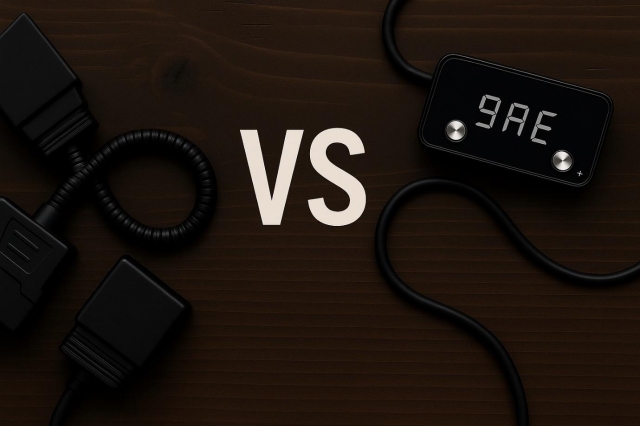Thinking about giving your car a little more attitude on the road? You’ve probably come across two names a lot: throttle controllers and performance chips. They both claim to boost your driving experience—but in very different ways. Whether you're trying to choose between the two or wondering if you can use both together, let’s break it down clearly and practically.
Why Change Anything in the First Place?
When cars roll off the production line, they're tuned to meet the needs of a global market. That means they have to comply with different emissions standards, work with varying fuel qualities, and cater to a wide range of driving habits. The result? Vehicles that are safe and reliable—but often a bit conservative in how they perform.
If you’ve ever felt like your car isn’t quite as responsive or exciting as it could be, it’s probably because the factory settings are designed more for efficiency and safety than fun. That’s where tuning tools like throttle controllers and performance chips come into play.
What Is a Throttle Controller?
A throttle controller changes how your gas pedal communicates with your car’s engine. Most modern vehicles use “drive-by-wire” throttle systems, meaning your pedal doesn’t control the throttle mechanically. Instead, when you press it, you’re sending a signal to the car’s computer (ECU), which then opens the throttle electronically.
Manufacturers often build in a slight delay between pedal input and engine response to make the ride smoother and more fuel-efficient. But that can make the car feel unresponsive—especially in city traffic or during quick lane changes.
Throttle controllers remove that delay. They adjust the signal between the pedal and the ECU to sharpen throttle response. The result? Your car feels much quicker to respond when you step on it.
Key Benefits of a Throttle Controller
- Faster throttle response
- Sportier pedal feel
- Better drivability in stop-and-go traffic
- Easy installation and removal
- No changes to engine maps or ECU
Just remember: throttle controllers don’t add any actual horsepower or torque. They change how the car feels, not how much power it has.
What Is a Performance Chip?
A performance chip, also known as a tuner or ECU chip, works on a much deeper level. It reprograms or adjusts key engine parameters like fuel delivery, ignition timing, and air-fuel ratios. On turbocharged vehicles, it can also alter boost pressure. In some cases, it may even adjust automatic transmission shift points.
The goal here is real engine optimization. With the right performance chip, you can unlock more horsepower, improved torque, smoother acceleration, and even better fuel economy under certain conditions.
What Can a Performance Chip Improve?
- Horsepower and torque output
- Acceleration and responsiveness
- Fuel efficiency in eco modes
- Engine behavior tailored to your driving style
- Turbo boost performance in turbocharged engines
Performance chips are especially useful if you do long highway drives, tow regularly, or just want your car to feel stronger and more confident on the road.
So, What’s the Difference?
It all comes down to feel vs. function.
- A throttle controller changes the sensitivity of the gas pedal. It makes your car feel quicker, even though it doesn’t change how much power the engine produces.
- A performance chip modifies how the engine operates. It adds real performance gains by adjusting how the car burns fuel, ignites spark, and responds under load.
To put it simply: throttle controllers fool your feet, performance chips fuel your engine.
Installation: Easier Than You Think
Both devices are designed with simplicity in mind.
- Throttle controllers plug in between the pedal and the ECU, often near the footwell. Most people can install one in 10–15 minutes without special tools.
- Performance chips usually connect to your car’s OBD2 port (the same one used for diagnostics). Some chips are plug-and-play, while others may need to be configured using a phone app or handheld programmer.
Both are non-invasive. That means you don’t need to cut wires or open up your engine. You can remove them at any time, and your car reverts to factory settings instantly.
Can You Use Both?
Yes—and many drivers do. Here’s how it works:
- The throttle controller sharpens response from the gas pedal.
- The performance chip gives the engine more power to respond with.
Used together, they create a noticeable transformation. Your car responds quicker and performs better. It’s a popular combo for drivers who want a sportier feel without diving into full engine modifications.
Are They Safe?
In a word: yes—provided you buy from a reputable brand.
- Throttle controllers don’t touch engine parameters. They’re safe, reversible, and unlikely to cause long-term issues.
- Performance chips, when properly made and installed, work within your engine’s safe operating limits. They’re built to give you more without stressing the mechanical components.
Avoid generic or too-good-to-be-true options. Always check compatibility with your make and model.
Which Should You Choose?
That depends on what you're after:
- Want a snappier feel in city driving or during daily commutes? Start with a throttle controller.
- Looking for real performance improvements—more torque, better highway pull, improved towing? Go for a performance chip.
- Want the best of both worlds? Combine them for a dramatically better driving experience.
Final Thoughts
Throttle controllers and performance chips may sound similar, but they offer different types of benefits. One improves how the car feels; the other changes how the car performs. Neither is inherently better—they just serve different purposes.
If you’re just starting to explore tuning, a throttle controller is a simple, cost-effective first step. But if you’re serious about unlocking your engine’s true potential, a performance chip is the key.
And if you’re the kind of driver who wants a car that reacts quicker and drives stronger, there’s no reason you can’t enjoy the benefits of both.






